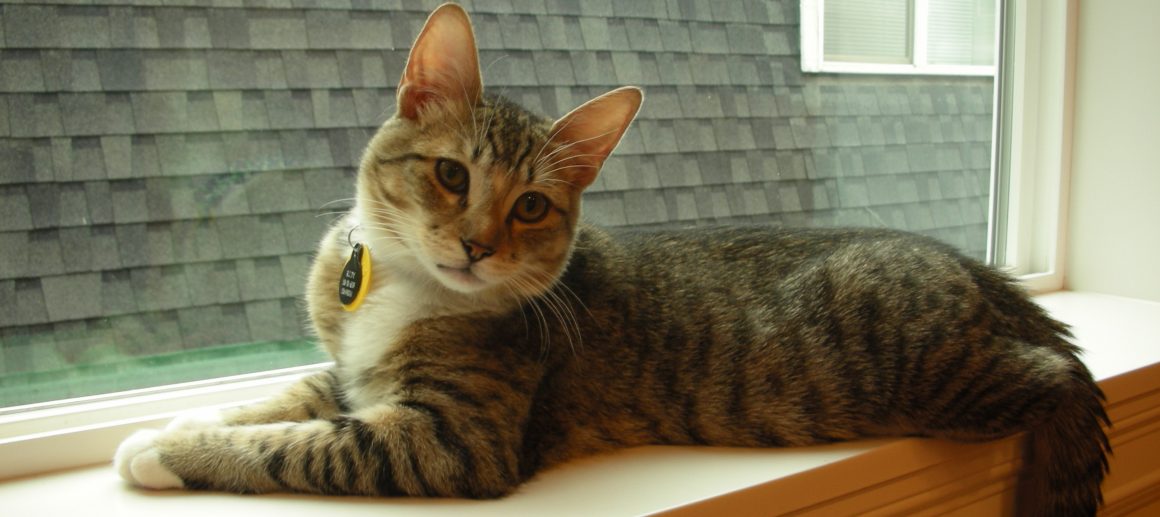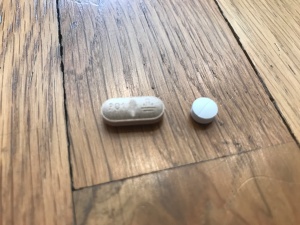Pimobendan (Vetmedin) is a drug that shows a lot of promise for congestive heart failure with pets. When Rudy's cardiologist prescribed it, he told us about another cat, who was in pretty desperate shape and losing his battle to CHF– but he responded beautifully while on pimobendan and was still doing well three years later! He nailed the right cocktail— and pimobendan was the key ingredient. Rudy also did well on pimobendan but, in the course of starting him on the medication, we unexpectedly opened up a whole new world. This short post describes what we discovered.
What is Pimobendan?
Pimobendan is an inotrope and also a vasodilator. I understand that it primarily works by making the heart contract more forcefully, enabling higher cardiac output. I also understand that most of the veterinary research on pimobendan involved dogs– and some cardiologists largely limit its use mostly to dogs. Nevertheless, there is evidence that it also works well in cats with CHF.
Dogs Versus Cats and Pulmonary Edema Versus Pleural Effusion
One of my alma maters' veterinary school provides a quick synopsis of congestive heart failure. In a nutshell, if the left side of the heart is affected, the most common effect is "pulmonary edema" (fluid accumulation in the lungs). By contrast, if the right side of the heart is affected, the most common effect is fluid accumulation outside the lungs– either as "ascites" (fluids build up in the abdomen) or "pleural effusion" (fluids build up in the chest cavity). If you have a pet with CHF, get used to seeing one or more of those terms a lot; hopefully, it will be in the negative (e.g. "patient shows an absence of pleural effusion clinically and on ultrasound examination") but do expect to see one or more of these terms because they are a common part of CHF.
As far as I can tell, neither form of fluid accumulation is preferable over the other. When fluids build up outside the lungs, they usually have to be drained with a needle. A thoracocentesis (or thoracentesis) is a scary sounding (but relatively benign) procedure to remove fluids from the chest cavity. Unfortunately, diuretics don't work effectively for removing this kind of fluid buildup. Repeated thoracentesis procedures can get quite expensive, but the biggest burden is really the personal stress of knowing that your kitty is having such a painful sounding procedure. In reality, Rudy (like many cats) was very calm during each procedure and never required more than a local anaesthia. Plus, he was pretty much back to normal afterwards. While vets will warn you about the risks associated with the procedure (such as injuring an organ or pneumothorax), my neighbor (a retired physician) assured me that, when using ultrasound guidance, the risks were pretty small. Bottom line– it's necessary and not something to stress too much over (although you wouldn't want to do it too often in a week because of quality of life issues).
Unlike pleural effusion, pulmonary edema (fluid inside the lungs) usually responds well to diuretics. In mild cases of CHF, increasing diuretics to remove this fluid may seem like a much preferable option to having a needle inserted into one's chest! The downside, unfortunately, is that extra diuretics can put more strain on the kidneys– and this can be an awful or impossible position to be in if the kidneys start to fail.
When I brought Rudy in for one of his thoracentesis procedures, one of the emergency veterinarians told me that there tends to be something odd with a cat's plumbing. For some reason, while dogs and many other mammals tend to develop pulmonary edema, cats tend to develop pleural effusion. He also told me that, in his experience, he tended to notice that there is a higher incidence of congestive heart failure in dogs while cats tended to develop chronic kidney disease instead. Figures that I would be the oddball who had a dog and a cat who both defied the trends. ;-(
Pimobendan, Cats, and Compounding
As I noted above, there's good evidence that pimobendan is useful for cats with CHF. Yet, take one look at a one milligram pimobendan tablet and it's obvious that cats are not its primary market.
On the left is a picture of a pimobendan tablet. In the picture, it's the much larger pill on the left side. The pill is about the size of a dime. Before I learned how to effectively give a cat a pill, that was way too big to give to Rudy (although later it would have been easy). What I think is strange is that it's only one milligram of actual medication– an incredibly minuscule amount! On the right side of the picture is a compounded version of same medication. It's a "tiny tab" of pimobendan compounded by Wedgewood Pharmacy in New Jersey. Your vet can call in just about any veterinary medicine and they can carefully compound it in a number of different forms (they can even do transdermal versions of some medications to avoid giving pills entirely). But the pill on the right is much easier to give to a cat because it's only about a quarter of inch across. Even this seems quite oversized for only 1 mg of medication, but it's a huge improvement when it comes to giving the medication to a cat!
Compounding involves taking a medication and preparing it in exact proportions to meet a specific need, such as changing dosages or forms of delivery. Compounding medication may be necessary when giving human medication to cats because kitties are so much smaller than people. For instance, Rudy took torsemide as a diuretic instead of furosemide (subject of a future post)– and compounding his medication was essential because the smallest human pill was many times too powerful for Rudy's tiny body.
My vet warned me, however, that medications are odd and that these oddities are magnified with compounding. You might think that, if you take the same dosage of the same chemical, the body should react in the same way. Sometimes it does– and sometimes it doesn't. It does make some sense that, if you have a medication that works as a pill, it may work differently when given transdermally because it is clearly absorbed differently. What isn't so obvious is that the same medication can be compounded by two different (and competent) pharmacists in the same proportions in very similar ways– and the body will react very differently to them. This happened to Rudy once when I had to have a medication compounded by a local (and very trustworthy) pharmacist when he had been taking the same medication compounded by a different pharmacist previously. The bottom line is that you really want to stick with what works best and, if you have to make changes, do it gradually. If a particular brand of medication works great, for instance, be careful before switching to a different brand or getting that medication compounded.
Compounding medication is a valuable– often essential– part of treating a cat with a chronic condition. In many cases, it can make life a lot better for your cat. In a future post, I'll describe how to use gelatin capsules to make life even better for your cat by combining medications (with your vet's approval, of course) and making them easier to swallow.
Of course, please remember that I'm not a veterinarian and that this post shouldn't be considered as medical advice for your pet. I can only tell you my experiences as a pet parent. You'll want to check with your vet before making any changes to your pet's care.

